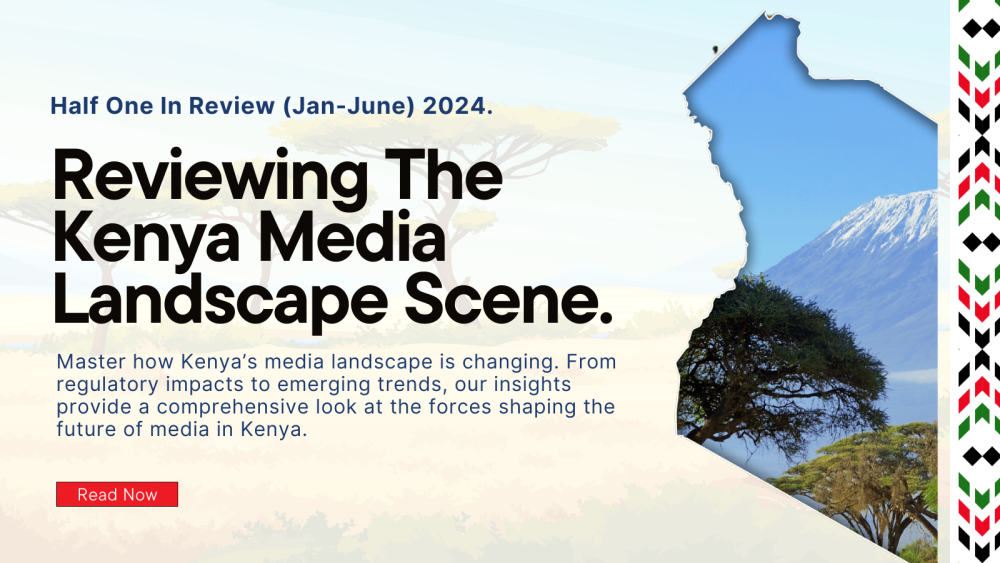Kenya 2024 Advertising Spends Drop By 19% |Kenya Commercial Bank, Safaricom, L'Oreal Group And Kenya Revenue Authority Emerge As Top Spenders| January- July 2024 Kenya Media Landscape Report

Kenya's media sector is recognized as one of the most developed and dynamic in Africa, with a diverse and well-financed landscape that plays a critical role in the country’s socio-political fabric. However, despite this vibrancy, the 2024 World Press Freedom Index, published by Reporters Without Borders, ranked Kenya at position 102 out of 180 countries, highlighting ongoing challenges in media freedom.
Kenya Press Freedom Under-Pressure
The decline in Kenya's press freedom ranking is largely attributed to political influence within the media sector. Many media houses in Kenya are owned by politicians, their allies, or individuals aligned with various political formations. This ownership structure has led to concerns about the independence of media outlets, with some journalists facing pressure to align their reporting with the interests of media owners.
The aftermath of the 2022 General Elections further underscored these challenges. The Media Council of Kenya reported that at least 25 journalists were attacked during post-election demonstrations, with violence stemming from both rioters and police forces. Such incidents often lead to self-censorship, as media professionals seek to avoid conflict with powerful political figures or economic repercussions.
In 2024, the situation was exacerbated when the government mandated that all its entities channel advertisements exclusively through the Kenya Broadcasting Corporation. The government also awarded exclusive publication rights to The Star newspaper, a move criticized for limiting revenue streams for other media houses and further constraining the financial independence of the press.
.png)
Growth In Television And Radio
Despite these challenges, Kenya’s media landscape continues to grow, particularly in television. Since the digital migration in 2016, there has been significant investment in digital TV media, especially in the digital terrestrial television (DTT) broadcasting platform. By the third quarter of 2023-2024, audiences had access to 351 television stations, offering a wide array of programming.
Citizen Leads TV Viewership And Ad Spends
Radio, too, has seen exponential growth over the last decade, particularly with the rise of vernacular stations broadcasting in local languages. These stations have garnered high audience affinity, as listeners often trust messages delivered in their native tongues. Swahili radio stations, with their extensive nationwide reach, continue to dominate in both listenership and advertising revenue.
Radio Jambo Dominates Ad Spends Share
Advertising Trends And Impact
The advertising landscape in Kenya has experienced notable shifts in 2024. Overall advertising expenditure across radio, TV, print, and out-of-home (OOH) platforms decreased by 19% in the first half of the year compared to the second half of 2023. This decline was driven by several factors, including a media focus on political updates, widespread flooding in April and May, and protests related to the 2024 Finance Bill.
Despite these challenges, certain sectors saw increased ad spending. The finance sector, personal care products, communication, and state bodies recorded significant growth in advertising expenditure, with KCB, L'Oréal Group, Safaricom, and the Kenya Revenue Authority emerging as top spenders.
However, the betting and gambling sector, traditionally a major contributor to advertising revenue, saw a 38% decrease in spending. This reduction was linked to new regulations, including a 15% tax on gross gaming revenue and a 1% monthly levy, aimed at curbing gambling among Kenya’s productive population.
Conclusion And Forecast
The outlook for Kenya’s media and advertising landscape remains uncertain. Factors contributing to this decline include government regulations impacting businesses, such as excise duties on betting brands, directives to advertise solely on national media outlets, and new statutory deductions like the housing levy. These regulations have increased operational costs for businesses, particularly small enterprises, posing significant challenges to their survival and growth.
Kenya’s media landscape is a complex and evolving ecosystem, marked by both growth and significant challenges. While the sector continues to expand in terms of media outlets and platforms, issues surrounding digital transformation, press freedom, and economic pressures present ongoing hurdles. The ability of Kenyan journalists to operate independently and the financial viability of media houses will be key determinants of the sector’s future trajectory.
Download your copy to gain comprehensive insights into the true state of the media environment, including predictions for H2 2024 and beyond.
At Reelanalytics, we help advertisers demonstrate the impact of their media investments and enhance their communication strategies with actionable insights. To learn more about our media solutions, contact us at marketing@reelanalytics.net.